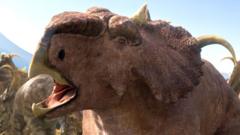Hidden beneath lush Canadian forests lies a thrilling mystery at Pipestone Creek, dubbed the "River of Death." This vast site is a graveyard of dinosaurs, with thousands of bones buried after a catastrophic event 72 million years ago. Palaeontologists, led by Professor Emily Bamforth, are on a quest to uncover how these creatures met their fate.
Armed with sledgehammers, the team cracks open layers of rock to reveal a treasure trove of fossils bursting from the earth. Among the finds are bones from Pachyrhinosaurus, a dinosaur about the size of a small car, noted for its distinctive horns and hefty frame. Each square meter of excavation could yield as many as 300 bones, creating a possible northern North American dinosaur hotspot.
These Pachyrhinosaurus are believed to have traveled together in enormous herds, likely migrating for food. This snapshot of the past presents an unprecedented opportunity to study a single species in such dense numbers—a rarity among fossils.
Nearby, the Deadfall Hills hosts even larger specimens, including remains of Edmontosaurus. These bones, washed ashore, provide insights into the surrounding ecosystem. The research team, including Jackson Sweder from the Philip J. Currie Dinosaur Museum, aims to piece together the ancient narrative based on the evidence collected.
Prof. Bamforth theorizes that a sudden cataclysm, likely a flash flood triggered by a storm, might have caused the entire herd to perish, an event captured in the sedimentary rock of Pipestone Creek. Each return to the site unearths more discoveries, fueling a fascination for this ancient world.
As they prepare for the next digging season, Prof. Bamforth emphasizes the ongoing nature of this archaeological adventure, promising new revelations concerning the Pachyrhinosaurus and their tragic journey in the face of disaster.



















